Fort Slemmer
On the far north end of the University’s campus (behind Marist Hall), on a slight knoll now covered with trees stands the former site of Fort Slemmer, a Civil War fort — one of 68 protecting Washington, D.C. from Confederate forces. Established on land seized by the government during the war, Fort Slemmer was built on the highest hill of farmland owned by E.J. Middleton. The fort was named after Lt. Adam Slemmer, a Pennsylvanian who distinguished himself as a defender of Fort Pickens in Florida. It was one of the city’s smaller forts and did not see any action during the war. It had a perimeter of only 93 yards, with an armament of three 32-pound guns and an 8-inch rifled cannon.
Find out more about Fort Slemmer here: https://service.catholic.edu/civil-rights-walking-tour/fort-slemmer/index.html
Old Soldier's Home
The Catholic University of America stands on land purchased adjacent to the grounds of the Old Soldiers' Home, a residence for Civil War veterans. This image of the CUA campus (pictured at left) in 1890 shows a largely undeveloped area of wooded land and pastures. New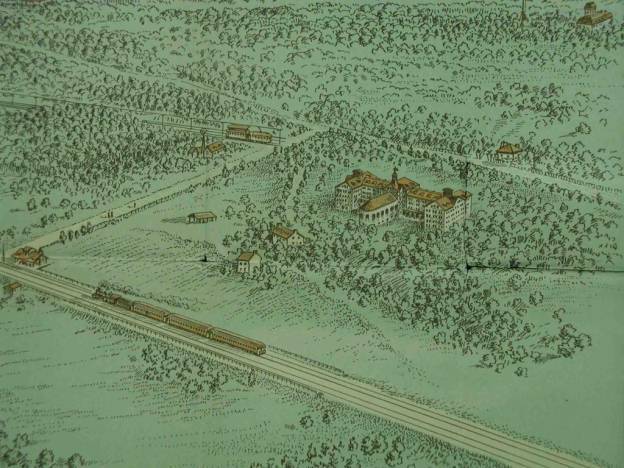 ly erected Caldwell Hall stands in the center of the image, St. Thomas Hall to the left. In the upper right is the Old Soldiers' Home. Connecting the university to the city center was the railroad, running across the bottom of the image, and the newly constructed electric streetcar line that ran up 4th Street to the southern edge of campus.
ly erected Caldwell Hall stands in the center of the image, St. Thomas Hall to the left. In the upper right is the Old Soldiers' Home. Connecting the university to the city center was the railroad, running across the bottom of the image, and the newly constructed electric streetcar line that ran up 4th Street to the southern edge of campus.
(Detail from the map "University Heights" , c. 1890)
World War I
In early 1918, the U.S. War Department, which would later become the Department of Defense, inaugurated the Student Army Training Corps (SATC). The SATC used over a hundred college campuses, including CUA, as training facilities for new Army officers during WWI. Instructors were hired under a temporary contract, with the colleges and universities being subsequently reimbursed for expenses by the government. CUA contributed nearly four hundred officers to the armed forces through this program. The SATC was later reorganized as the Reserve Officer Training Corps (ROTC) and continues to flourish today.
Upon American entry into WWI, the War Department was scrambling to develop U.S. chemical weapons capabilities comparable to those of the European powers and established the Offensive Branch of the newly formed Chemical Warfare Service at Catholic University. This unit, under the leadership of Dr. Winford Lee Lewis, was given the task of researching and developing new chemical warfare agents for the Army. In April 1918 Rev. John Griffin directed Lewis to the research of one of his former students, Fr. Julius Arthur Nieuwland, who had discovered a highly toxic compound in 1903 while working on his doctoral dissertation at CUA. Lewis' team determined that this toxic substance would be highly effective as a weapon and christened "lewisite." After conducting further research at nearby American University, the Army began large scale production of the compound at a secret plant in Willoughby, Ohio, in November 1918. This was, however, the same month that the war ended, and lewisite was never deployed on the battlefield by American troops.
One of Catholic University's most distinguished alumni veterans was Father Francis P. Duffy of the "Fighting Sixty-ninth" infantry regiment. When his unit saw action on the Western Front, Duffy accompanied the litter bearers in recovering the wounded and was frequently seen in the thick of battle. Recognized by the regimental commander, Lieutenant Colonel William "Wild Bill" Donovan, as a critical element in the unit's morale and cohesion, Duffy's leadership role went beyond that of a normal chaplain. General Douglas MacArthur stated later that Duffy was briefly considered for the post of regimental commander. For his actions in the war, Duffy was awarded the Distinguished Service Cross, the Distinguished Service Medal, the Conspicuous Service Cross, the Légion d'Honneur, and the Croix de Guerre. Father Duffy remains the most highly decorated cleric in the history of the U.S. Army.
Fifteen Catholic University students gave their lives in the First World War. A memorial was erected on campus and dedicated in their honor (pictured below) . Later it was removed, however, after being damaged. 
More information about CUA during WWI can be found at the link below: https://www.lib.cua.edu/wordpress/newsevents/9129/
World War II
After the declaration of war, lay students began military drilling on campus, forming three companies led by university instructors with prior military experience. A new gymnasium, ‘The Drill Hall,’ (which is now the Crough Building, housing the School of Architecture) served both recreational and military needs. Many students also joined reserve or active-duty units.
Throughout the war, CUA hosted the United Service Organization (USO) leader training on campus. These two-week training courses consisted of lectures, workshops, and considerable fieldwork in local entertainment venues. USO leaders were expected to coordinate entertainment and recreational activities for the benefit of U.S. service personnel deployed overseas. In total, about seventy students participated in the USO training at Catholic University, with a ratio of two males to every one female. CUA also participated in the Army Specialized Training Program (ASTP) to meet wartime demands for specialized skills. Along with two-hundred and twenty other schools across the country, Catholic University turned its educational efforts to teaching soldiers engineering, foreign languages, psychology, and medical sciences. Meanwhile, Albert and Gibbons Halls were leased to the U.S. Navy for use as a paymaster training school, graduating nearly six hundred paymasters. The campus community engaged in many other activities to support the war effort, including the promotion of Liberty Bonds and participation in Pope Pius XII's "Day of Prayer for Peace" on November 24, 1940.
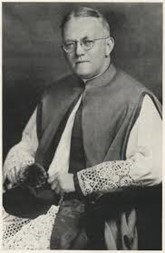 Catholic University’s Rev. Dr. Peter Guilday served as one of the SATC Regional Vice-Directors.
Catholic University’s Rev. Dr. Peter Guilday served as one of the SATC Regional Vice-Directors.
By November 1942, there were 525 members of the CUA community serving in the armed forces in some capacity. Twenty-seven of these were faculty members. One professor who answered the call of duty was Father Clement Falter. Fr. Falter served as a Navy Chaplain on board the USS Joseph Howes. He participated in Operation Torch, the U.S. Military's first major landing operation of the war. He went ashore with the troops at Fedals, Morocco, where he was killed in action. Fr. Falter was the first American Catholic Chaplin to be killed in action on foreign soil.
One of the former leading members of the CUA track team, Lt. John Corbett, was killed in action at Bairoko Harbor, New Georgia, in Solomon Islands. Despite being twice-wounded, Lt. Corbett maneuvered his platoon in a steady advance against strong enemy resistance. Disregarding his own safety for the sake of his men and their mission, he continued to direct his platoon's fire until he was finally killed. He is buried at Arlington National Cemetery and was posthumously awarded both the Catholic University Harris Trophy and the Distinguished Service Cross.
By war’s end, some eight-hundred CUA alumni and students had served in the military. More than fifty of them had served as chaplains. From the end of World War II until 1950, more than 2.3 million military veterans studied at colleges and universities in the United States, making use of the G. I. Bill. At the peak of veteran student enrollment in the academic year 1949/50, CUA counted 4,757 students, almost double the number of 1940/41. The University’s postwar efforts included a rehabilitation school for wounded soldiers and administrating the Knights of Columbus (KofC) Scholarship for veterans. KofC still provides scholarships for veterans even today.
Find out more information here: http://www.kofc.org/en/members/programs/military-activities/scholarships.html
Several Catholic University students gave the last full measure of their devotion in the fight against Nazi Germany and Imperial Japan. Thirty-four of them never returned from the battlefields of Europe and Asia.
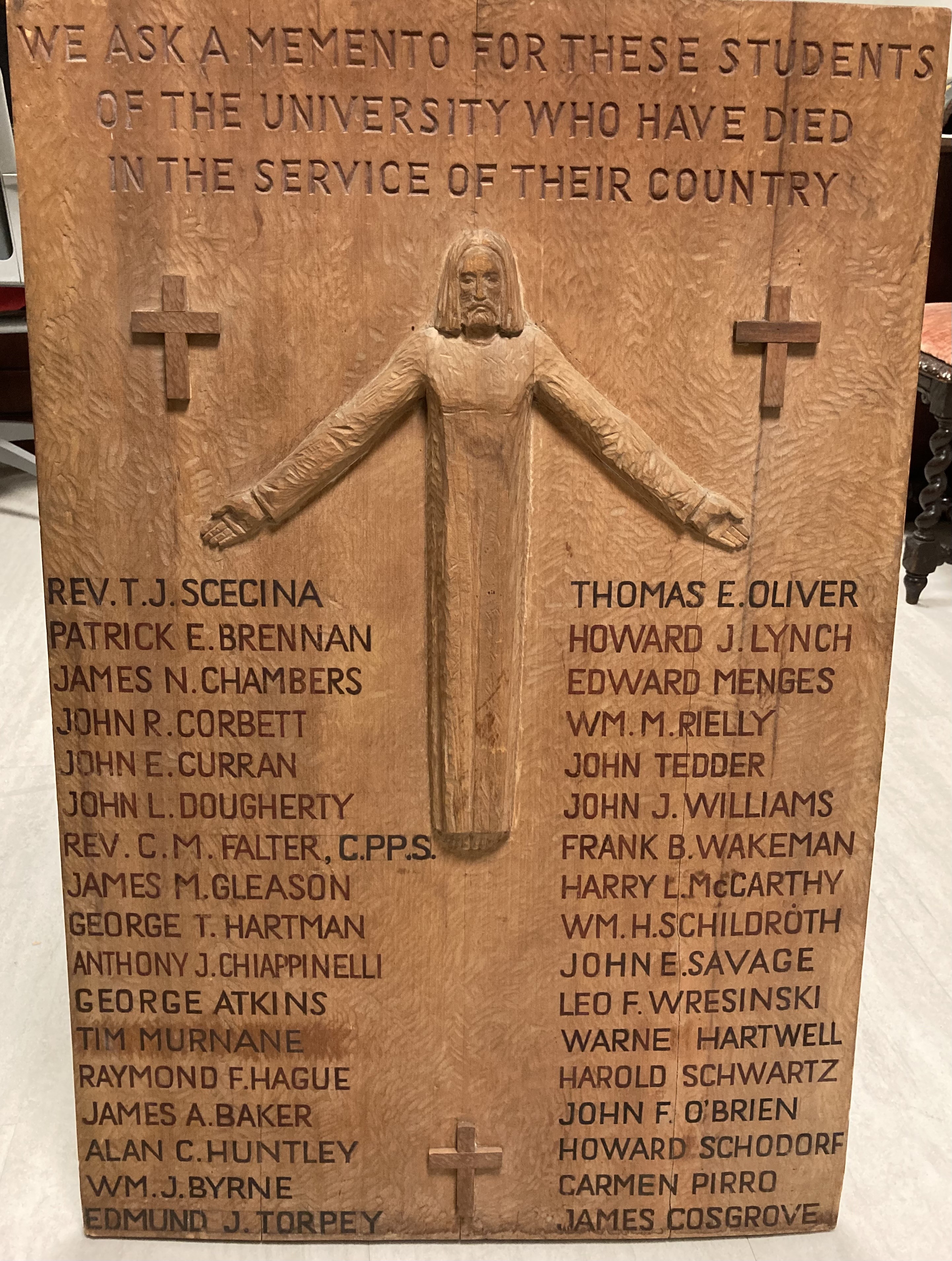
Fr. Emil Kapaun
Father Emil Kapuan was a Catholic Priest who served as an Army Chaplain in the Burma theater during World War II. After the war he earned a master’s degree at Catholic University in 1948. But he returned to active duty with the Army and served with distinction in the Korean War. At the Battle of Unsan, Fr. Kapaun repeatedly braved enemy fire and rescued nearly forty men until he was captured by Chinese forces. As a POW he was greatly admired for the selfless devotion he showed to his fellow prisoners. He dug latrines, mediated disputes, and gave away his own food to raise morale. He also stood up against communist indoctrination, smuggled medicine to the sick, and led the men in prayer. Fr. Kapaun finally died of malnutrition and pneumonia after enduring months of brutal captivity. In 1993, Pope John Paul II declared him a Servant of God, the first stage on the path to canonization. In 2013, Kapaun was awarded the Medal of Honor for his actions in Korea. He is the ninth American military chaplain to receive this award.
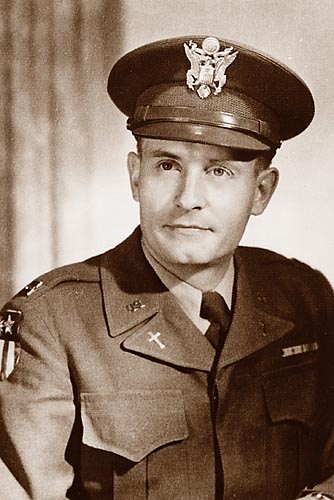
Air Force ROTC Detachment 135 and the Vietnam Era
In 1951, the Catholic University of America was chosen as one of only 58 universities across the country to host an Air Force ROTC program, and Detachment 135 was established on campus in September of that year. The Detachment's inaugural class consisted of a little over 100 cadets, and their first cadre commander was Col. Joseph S. Magrath. AFROTC allowed students to participate in a basic two-year program, with the option of continuing on to the advanced program, which entailed another two years of training and a commission in the U.S. Air Force upon graduation. The basic program was open to any male students within the colleges of Arts and Sciences, Engineering, and Architecture who met the physical requirements. In addition to Air Science classes, cadets also conducted weekly drills and physical exercise on the Basilica lawn in front of Gibbons Hall. Detachment 135 became a fixture of campus life, hosting balls, winning awards, and even fielding its own drill and color guard team, the Brennan Rifles.
During the 1960's, however, ROTC also became a way for some students to procure a draft deferment and to avoid potential deployment to Vietnam. Just as it was throughout America, the War in Vietnam was an increasingly polarizing issue at CUA. Because of its visibility on campus, Detachment 135 became a target for scrutiny and anxiety about the war from both sides of the political spectrum. While some accused ROTC instructors of assigning pro-communist readings to the cadets, others argued that hosting an ROTC unit at all was antithetical to the mission of a Catholic school. Debate swirled in the opinion columns of the school newspaper, The Tower. Nonproliferation talks, marches for peace, the DC riots of 1968, and increased campus security initiatives all contributed to a growing divide about the future of ROTC on campus. But these controversies were not the ultimate reason for the detachment's eventual casing of the colors.
The Vietnam War came to a close in 1975, and with it ended the draft. The U.S. Military underwent a major effort to professionalize and reduce the size of the force, leading to closure of ROTC programs across the country. In the middle of March 1975, the Air Force decided to disband Detachment 135, folding its corps of cadets into the nearby program at Howard University, Detachment 130, where CUA students still participate in AFROTC to this day. Lt. Col. William Donohue, the CUA detachment's last commander, remarked that the disbandment was not due to issues at Catholic University specifically, but that the "demand for officers had declined as well due to force level cut backs in the armed forces, [making Detachment 135] a victim of the times."
The Modern Era
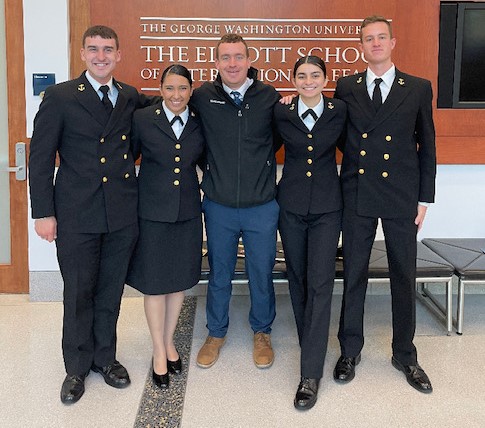 In 2018, the Catholic University of America expanded it's military population by welcoming it's first cohort of Naval ROTC midshipmen who would graduate in the class of 2022, joining the Army and Air Force programs already on campus.
In 2018, the Catholic University of America expanded it's military population by welcoming it's first cohort of Naval ROTC midshipmen who would graduate in the class of 2022, joining the Army and Air Force programs already on campus.
In Summer 2020, the university established the Office of Military and Veteran Student Services to centralize oversight and support for the university's ROTC cadets and military-affiliated student populations. The impact was seen in the freshman classes of 2021 and 2022, which where the largest incoming ROTC cohorts at Catholic University since the Vietnam War.
Catholic University's tradition of support for veterans has also continued into the modern era. In Fall 2021, the University partnered with the Department of Veterans Affairs to become an affiliated institution with the Veterans Rapid Retraining Assistance Program- joining the nationwide effort of rebuilding from the economic impact of the COVID pandemic of 2020.
In Summer 2022, LTC Erhan Bedestani, an Army Officer studying at the Columbus School of Law, was selected as a Pat Tillman Foundation Scholar- the first in the history of the university. The Pat Tillman Foundation Scholarship Application is one of the most selective Veteran fellowships nationwide, where through a highly selective process it seeks to support the next generation of private and public sector leaders from the ranks of military affiliated students.
The appearance of U.S. Department of Defense (DoD) visual information does not imply or constitute DoD endorsement.
